|
Regarding Joseph Smith's death at Carthage Jail, Doctrine
and Covenants 135:4 says:
"When
Joseph went to Carthage to deliver himself up to the pretended
requirements of the law, two or three days previous to
his assassination, he said: ďI am going like a lamb
to the slaughter; but I am calm as a summerís morning;
I have a conscience void of offense towards God, and towards
all men. I SHALL DIE INNOCENT, AND IT SHALL YET BE
SAID OF MEóHE WAS MURDERED IN COLD BLOOD." (emphasis
in the original)
This often-repeated
idea of innocent martyrdom is not supported by the official
historical record. Fom the Official History of the Church,
we learn:
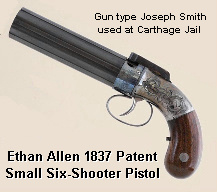 "Elder
Cyrus H. Wheelock came in to see us, and when he was about
leaving drew a small pistol, a six-shooter, from his pocket,
remarking at the same time, 'Would any of you like to have
this?' Brother Joseph immediately replied, 'Yes, give it to
me,' whereupon he took the pistol, and put it in his pantaloons
pocket." "Elder
Cyrus H. Wheelock came in to see us, and when he was about
leaving drew a small pistol, a six-shooter, from his pocket,
remarking at the same time, 'Would any of you like to have
this?' Brother Joseph immediately replied, 'Yes, give it to
me,' whereupon he took the pistol, and put it in his pantaloons
pocket." 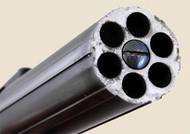 "The
pistol was a six-shooting revolver, of Allen's patent; it
belonged to me, and was one that I furnished to Brother
Wheelock when he talked of going with me to the east, previous
to our coming to Carthage. I have it now in my possession.
Brother Wheelock went out on some errand, and was not suffered
to return." "The
pistol was a six-shooting revolver, of Allen's patent; it
belonged to me, and was one that I furnished to Brother
Wheelock when he talked of going with me to the east, previous
to our coming to Carthage. I have it now in my possession.
Brother Wheelock went out on some errand, and was not suffered
to return."
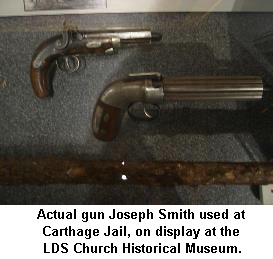 "I
shall never forget the deep feeling of sympathy and regard
manifested in the countenance of Brother Joseph as he drew
nigh to Hyrum, and, leaning over him, exclaimed, 'Oh! my
poor, dear brother Hyrum!' He, however, instantly arose,
and with a firm, quick step, and a determined expression
of countenance, approached the door, and pulling the
six-shooter left by Brother Wheelock from his pocket, opened
the door slightly, and snapped the pistol six successive
times; only three of the barrels, however, were discharged.
I afterwards understood that two or three were wounded by
these discharges, two of whom, I am informed, died." "I
shall never forget the deep feeling of sympathy and regard
manifested in the countenance of Brother Joseph as he drew
nigh to Hyrum, and, leaning over him, exclaimed, 'Oh! my
poor, dear brother Hyrum!' He, however, instantly arose,
and with a firm, quick step, and a determined expression
of countenance, approached the door, and pulling the
six-shooter left by Brother Wheelock from his pocket, opened
the door slightly, and snapped the pistol six successive
times; only three of the barrels, however, were discharged.
I afterwards understood that two or three were wounded by
these discharges, two of whom, I am informed, died."
"I
had in my hands a large, strong hickory stick, brought there
by Brother Markham, and left by him, which I had seized
as soon as I saw the mob approach; and while Brother
Joseph was firing the pistol, I stood close behind him.
As soon as he had discharged it he stepped back, and I immediately
took his place next to the door, while he occupied the one
I had done while he was shooting."
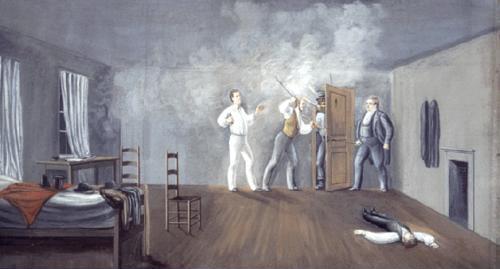
"Brother Richards, at this time, had a knotty walking-stick
in his hands belonging to me, and stood next to Brother
Joseph, a little farther from the door, in an oblique direction,
apparently to avoid the rake of the fire from the door.
The firing of Brother Joseph made our assailants pause
for a moment; very soon after, however, they pushed
the door some distance open, and protruded and discharged
their guns into the room, when I parried them off with my
stick, giving another direction to the balls."
"It
certainly was a terrible scene: streams of fire as thick
as my arm passed by me as these men fired, and, unarmed
as we were, it looked like certain death. I remember feeling
as though my time had come, but I do not know when, in any
critical position, I was more calm, unruffled, energetic,
and acted with more promptness and decision. It certainly
was far from pleasant to be so near the muzzles of those
firearms as they belched forth their liquid flames and deadly
balls. While I was engaged in parrying the guns, Brother
Joseph said, 'That's right, Brother Taylor, parry them off
as well as you can.' These were the last words I ever heard
him speak on earth."
- Official History of the Church, Vol. 7, p.100-103
Reporter
John Hay, of the Atlantic Monthly identified three
men who were shot by Joseph Smith: John Wills in the arm,
William Vorhees in the shoulder, and William Gallagher in
the face. Hay was a son of Charles Hay, a surgeon of the
Carthage militia and apparently a member of the mob.
"Smith
had two loaded six-barrelled revolvers in his room. How
a man on trial for capital offences came to be supplied
with such luxuries is a mystery that perhaps only one
man could fully have solved; and as General Deming, the
Jack-Mormon sheriff, died soon after, and left no explanation
of the matter, investigation is effectually baffled. But
the four shots which I have chronicled, and two which
had no billet, exhausted one pistol, and the enemy gave
Smith no time to use the other. Severely wounded
as he was, he ran to the window, which was open to receive
the fresh June air, and half leaped, half fell, into the
jail yard below."
-
John Hay, "The Mormon Prophet's Tragedy," Atlantic
Monthly (December 1869) 671-678.
In another conemporary
account from a faithful Latter-Day Saint:
"Of
the three barrels discharged by Joseph, it is believed
he hit three men: an Irishman named Wells-who
was in the mob from his love of a brawl-in the arm; Voorhees-an
oversized kid from Bear Creek known for his lack of good
sense-in the shoulder; and a man named Gallagher-a Southerner
from the Mississippi Bottom-in the face."
"Two
other men were known to get hit in the hall, one a man
named Townsend from Fort Madison, Iowa Territory, who
died nine months later from the arm wound that wouldn't
heal, and another named Mills, who was shot in the arm."
- Elder Reed Blake, 24 Hours to Martyrdom, p. 129
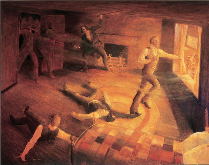 Smith's
final conscious act was to prevent his death, not give it
up. He went to the window and attempted to utter the Masonic
distress cry of "O Lord My God! Is there no help for the
widow's son?"
D&C Section
135 is part of John Taylor's account of the incident. It states:
"Joseph leapt from the window, and was shot dead in the attempt,
exclaiming 'O Lord my God!'" Smith's
final conscious act was to prevent his death, not give it
up. He went to the window and attempted to utter the Masonic
distress cry of "O Lord My God! Is there no help for the
widow's son?"
D&C Section
135 is part of John Taylor's account of the incident. It states:
"Joseph leapt from the window, and was shot dead in the attempt,
exclaiming 'O Lord my God!'"
That "canonized"
version of events gives one the false impression that Smith
was praying to God. The edited D&C version omits Heber C.
Kimball's details of Smith's actions:
"When
the enemy surrounded the jail, rushed up the stairway,
and killed Hyrum Smith, Joseph stood at the open window,
his martyr-cry being these words, 'O Lord My God! 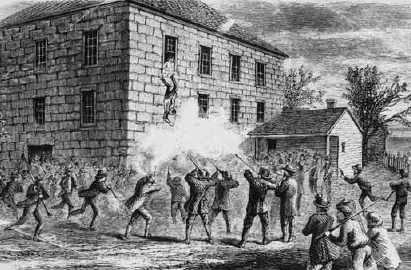 This
was not the beginning of a prayer, because Joseph Smith
did not pray in that manner. This brave, young man who
knew that death was near, started to repeat the distress
signal of the Masons, expecting thereby to gain
the protection its members are pledged to give a brother
in distress." This
was not the beginning of a prayer, because Joseph Smith
did not pray in that manner. This brave, young man who
knew that death was near, started to repeat the distress
signal of the Masons, expecting thereby to gain
the protection its members are pledged to give a brother
in distress."
- Mormonism and Masonry, p. 16-17
"President
Young said the people of the United States had sought
our destruction and they had used every Exertion to perfect
it. They have worked through the masonic institution to
perfect it. Joseph & Hyrum Smith were Master Masons
and they were put to death by masons or through there
instigation and he gave the sign of distress & he
was shot by masons while in the act."
- Wilford Woodruff's Journal, August 19th, 1860, Volume
5
One
of Joseph Smith's polygamous wives, Zina D. Huntington,
declared:
"I
am the widow of a master mason, who, when leaping from
the window of Carthage Jail pierced with bullets, made
the masonic sign of distress."
- Latter-day Saint Biographical Encyclopedia, Andrew
Jenson, Volume 1, page 698
Smith had
good reason to believe that Masons might be in the crowd outside,
because earlier that day, he had smuggled an order to Nauvoo
Legion commander Jonathan Dunham to come break them out of
the jail. But Dunham refused to obey the illegal order, knowing
that bringing Mormon troops to Carthage might result in all-out
civil war.
And in
fact, immediately after the Smithand Hyrum were killed, a
rumor began amongst the mobbers that the Mormons were on their
way from Nauvoo. That prospect made the mob scatter, and probably
saved John Taylor's and Willard Richards' lives.
Conclusion
Despite
popular Mormon folklore, Joseph Smith did not give his life
innocently "like a lamb to the slaughter" in martyrom.
He died after shooting three men with a pistol and desperately
trying to prevent his death even with his last utterance. |